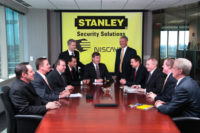For Jeff Schoepf, CPP, security director for a major light metals manufacturer in Pennsylvania, keeping tracking of employees is a safety issue. Schoepf uses a man-down radio system from Motorola that ensures that employees who walk through the company’s 125 outdoor acres can get help quickly if they need it. “As long as someone is in an upright position, the alarm won’t sound,” he says. “However, if someone falls ill and hits the ground, there is a mechanism on the radio that sends an alarm to our gatehouse. Our gatehouse guard first will verbally check with the person to make sure he’s ok. If there’s no response, he’ll send help.” Even better, the security guard can be guided to the area by sound and continuously talk on his/her radio to the guardhouse. “We’ve never had any incidents and we’ve never had to use it,” Schoepf says, “but we do make it available to our employees when they’re on our grounds.”
Similarly, for John Imhoff, director, office of firm security at Ernst & Young, a travel locator service is of great benefit to keep track of the firm’s employees, for safety reasons as well. “As you might imagine our people are very mobile emanating from all places to all places globally to bring unique skill sets and knowledge to bear on our clients’ needs,” Imhoff says. “Being able to quickly and accurately detail who might be in harm’s way when a security event occurs is very important to us.”
For example, in July 2005, when the London Underground bombings occurred, Imhoff and his staff wanted to account for its people and to know that none had been adversely impacted, and to steer those who might be in the vicinity away from the ongoing events. “Fortunately, we were able to quickly make that determination and communicate with those in the vicinity. The locator service contributed greatly in that regard,” he says. “The system was also beneficial in the recent Chilean earthquake aftermath. The examples go on with queries happening several times per month on average. It’s also an integral part of our pandemic planning allowing us to see retrospectively who might have traveled to a destination or been on a flight with an outbreak of such a communicable disease,” he adds. “Conversely, we can look into impending travel plans to security ‘hot spots’ and counsel travelers accordingly. Thailand is an example of a destination normally a relatively benign travel destination, but of late is presenting some challenging security issues.”
Imhoff says he manages the system with great respect for personal privacy well beyond any strictures imposed by law and is very open with Ernst & Young people that the system is in use. “Recently, I reached out to a couple of travelers in Kyrgyzstan during the military coup and received a somewhat surprised but appreciative message from one of the people who was possibly on-site to say ‘Thanks and how did you know I was there?’ He was very pleased to know this safety net existed,” he says.
Tracking Patients in Medical Care
Talk about a great patient experience that also enhances security. At the new Roy and Patricia Disney Cancer Center in San Fernando Valley, Calif., a patient is tracked once he or she enters the facility, and their experience is personalized to their personal needs while they are there. That all means that wait times are reduced, and it’s easier for patients to locate their treatment area. For security, it means finding a patient easier if a problem arises, for example, if a patient falls ill.For example, through the use of Radio Frequency Identification (RFID) technologies, a clinician is paged to the appointed clinical treatment location when a patient arrives. Upon check-in, receptionists greet patients by name and clinicians identify a patient’s location, receive the scheduled treatment plan, and prepare procedures or treatment rooms in advance – all of which maximizes clinician efficiency and reduces patient wait time and anxiety.
And when a patient enters a treatment room, the lighting, music and temperature adjust to their preferences to further personalize the experience.
Opened in February, the Disney Cancer Center provides diagnosis, treatment, professional counseling, support groups and educational resources from one 55,000-square-foot location. Its holistic design is intended to create a peaceful sanctuary for cancer patients, incorporating art, therapeutic music and soothing colors.
According to Raymond Lowe, information services director for Providence Saint Joseph Medical Center, the original intent of the system was to provide patient tracking. “But we also need to understand the traffic plans of an individual – where they are at what time, for example, and since we are using an integrated passive reader that is displayed on an active RFID viewing station, we can do that,” he says.
Employees can be tracked with the same system when they carry one of the center’s wireless phones.
From the initial planning process to implementation, the IT infrastructure at the Center was designed to work with the business and building systems, and clinical operations. Clinical systems, including radiology and telemetry, and a nurse call system operate on the network.
The Technology Contracting model from Johnson Controls also helps the Center assess its technology needs and design one IP backbone – instead of multiple networks – that can be used by all the building automation, security, clinical and administrative systems to help reduce infrastructure costs.
The model also integrates systems such as security and fire systems, in addition to building management, unified voice and data network; heating and air conditioning; and lighting to provide authorized staff with access to real-time monitoring and controls data so they can make adjustments accordingly.
What about Privacy?
One privacy group says that tracking consumers has reached alarming levels and it is calling on Congress to better protect consumer privacy. The Center for Digital Democracy, a coalition of 11 consumer and privacy advocacy organizations, recent sent a letter to the U.S. Congress outlining the protections any online privacy legislation must include.The coalition said that industry self-regulation has not provided meaningful consumer protection and stressed that legislation is needed.
“This tracking is an invasion of privacy... Consumers now rely on the Internet and other digital services for a wide variety of transactions,” the groups wrote. “These include sensitive activities, such as health and financial matters. In these contexts, tracking people’s every move online is not simply a matter of convenience or relevance. It presents serious risks to consumers’ privacy, security and dignity.”
The consumer and privacy groups noted that for the past four decades the foundation of U.S. privacy policies has been based on Fair Information Practices: collection limitation, data quality, purpose specification, use limitation, security safeguards, openness, individual participation, and accountability.
They called on Congress to apply those principles in passing legislation to protect consumers online.
“Consumers need rights, and profiling should have limits. Behavioral tracking and targeting can be used to take advantage of vulnerable individuals, or to unfairly discriminate against people,” the groups wrote.
The groups argue that self-regulation for privacy will not protect consumers, and that law enforcement access to personal data should require a warrant. They are also requesting that the ability of websites and ad networks to collect or use behavioral data should be limited to 24 hours, and that websites should not collect or use sensitive information for behavioral tracking or targeting. The FTC should be tasked with defining sensitive information, it suggests, and that personal data should be obtained only by lawful and fair means and, unless unlawful or impossible, with the knowledge or consent of the individual.



